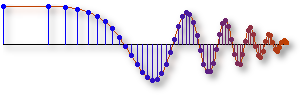C. Fourier Series
In this appendix, we describe the mathematical theory of Fourier series. We use specific examples of pulse waves, triangular
waves, and rectified sinusoids to show how the Fourier series representation is obtained
and how each signal's spectrum is defined by the Fourier series. Finally, we focus on
general properties of the Fourier series which not only extend the understanding of the
frequency domain, but also make the job of signal analysis easier in practice.
Parseval's theorem and the approximation error from finite synthesis are discussed.
Demos - MATLAB 1
This MATLAB demo reconstructs a square, triangle, or
sawtooth waveform, using a given number of Fourier Series coefficients.

